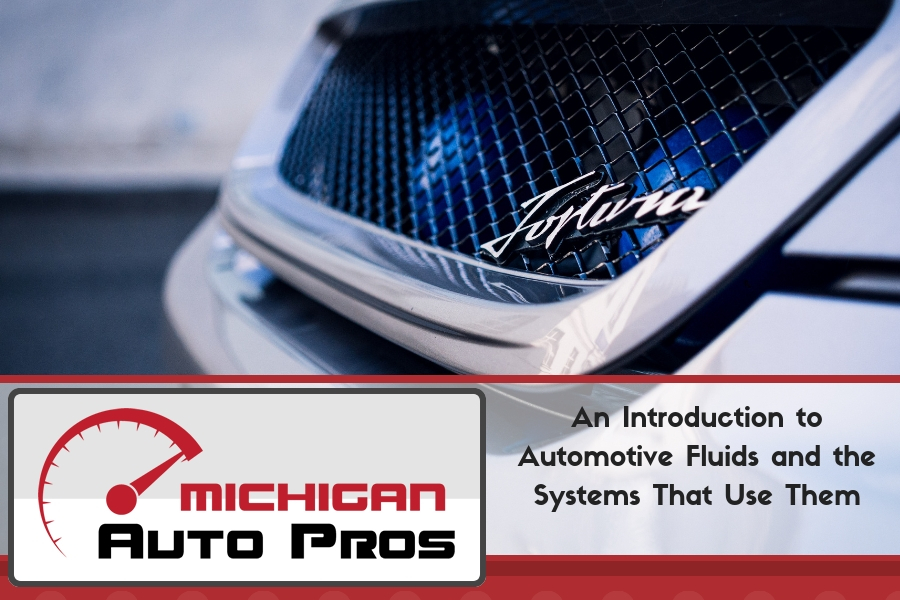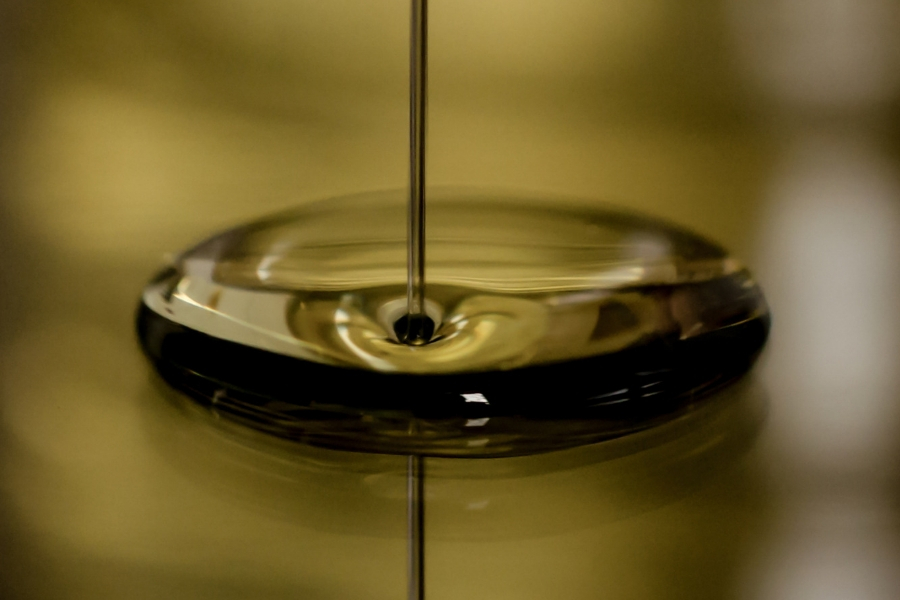Does your car mark its territory? Seeing any liquid coming from your car can be alarming. Most cars today require several fluids to keep them running properly. These range from essential, to expendable. It’s obviously no surprise that wiper fluid is meant to be expelled. Read on to better understand what, if any, action should be taken if you suspect a leak.
An Introduction to Automotive Fluids and the Systems That Use Them
When most people think of automotive fluids, they think of oil – and for good reason. Oil is the lifeblood of a vehicle. It whisks away heat, provides a thin layer for critical engine parts to glide upon, and removes particles and impurities that build up inside an engine. Oil is not meant to be seen outside of the vehicle. Fresh oil often has the color of straw and is mildly transparent. As it is circulated throughout the engine, it darkens in color before eventually becoming dark grey and even black.
Several factors can lead to an oil leak, and many of them are benign. Common problem areas are oil filters and drain plugs. Nearly all oil filters are of the screw-on type and can leak oil if not properly tightened. The same goes for the drain plug. Oftentimes, the leak will be mild or nonexistent when the car is off but become more noticeable when the engine is running. This is because of the oil pressure generated by the engine, which forces oil through any improperly tightened components. Simply tightening any leaky areas will generally resolve the problem.
Other instances of oil leaks can stem from worn gaskets. This poses a bit of a problem for the less mechanically inclined, as replacing a gasket can be a bit of a challenge without proper tools. If you suspect an oil leak, it’s best to bring your car to a qualified technician.

Power Steering Fluid
The near effortless steering of a modern car is achieved through a sophisticated hydraulic system. At the center of this system is power steering fluid. When you turn the wheel, the fluid is compressed and greatly reduces felt resistance. Of course, this fluid must be maintained at the optimum level.
A vehicle that is low on or leaking power steering fluid may feel as if the steering wheel is tightening up. It may be accompanied by a whirring or whining sound, as the pump struggles to flow a liquid that is not there. Power steering systems rely on the use of many hoses and seals. Some also incorporate a small cooler, which looks something like a miniature radiator. Rubber seals, gaskets, and hoses are common points of failure. Normal use will eventually degrade these components. Expect to see faster wear when driving in extreme conditions. Fixing a leaky power steering system doesn’t need to be terribly expensive, although costs will mount as the problem gets worse. There is a clear safety component to a faulty steering system as well, and for this reason above all others, it’s best to get the car to qualified personnel should you suspect a leak or have trouble steering.
Coolant
Perhaps the second most vital fluid is coolant (often called “antifreeze”). Nearly all cars on the road today rely on coolant to keep the engine…well…cool. Smaller engines like that on your lawn mower and many motorcycles are air-cooled. They have visible metal fins, which help air flow over the engine and remove heat as it builds up. However, engines that create more power, are built to tighter tolerances, or concealed in an engine bay require an active cooling method. This is where coolant comes in.
Your car’s cooling system consists primarily of a radiator, water pump, and a whole bunch of hoses. Throughout the engine is a network of channels through which coolant flows, absorbing heat before being pumped through the radiator. It’s then cooled by air passing through the front grille, before being returned to the engine. This cycles continuously for as long as the engine is on.
If your cooling system fails, engine temperatures will quickly rise to dangerous levels. Engine coolant has an almost neon-like yellow or green color, not unlike your favorite sports drink. Because the coolant system requires fairly high pressure to function, it’s essential that hoses be clamped properly. If not, leaking is all but guaranteed. Radiators can often develop a hole, which is easily patched, but will leak until fixed. If the cooling system is filled too high, excess coolant may seep out. Most cooling systems feature an overflow box, which allows excess fluid to collect as it vaporizes under high temperatures. If this box is filled too high, leaking will occur. If components are worn, sometimes the coolant will have an orange tinge to it, from a buildup of rust. If you suspect a leak, feel free to pop the hood and inspect – but be careful. Coolant is hot, and under tremendous pressure. Loosening any connections, or the radiator cap, will unleash a geyser of scalding coolant which can cause serious burns. Unless you know what you’re looking for, it’s best to consult with your service pro.
Transmission Fluid
Cars with both automatic and manual transmissions use transmission fluid. Transmission fluid is essentially oil engineered for the stresses a transmission will place on it. In a manual transmission, fluid can become contaminated as bearings, gears, and synchronizers wear. Tiny slivers of metal will shear off under normal use. Over time, this can lend an abrasive property to oil which contradicts its intended purpose. Automatic transmissions generate much higher heat, and the oil will begin to break down in a similar fashion to engine oil. Like manual transmissions, automatics are also faced with a buildup of contaminants if the oil isn’t changed regularly.
Because of its location, fluid leaking from a transmission will often meet other hot parts of a vehicle. The scent of burning transmission fluid can sometimes have a distinctly electrical smell. Common causes for leaky transmissions are worn hoses, faulty gaskets, or a hole in the oil pan. This can sometimes be caused by road debris. A minor leak won’t cause immediate damage but should be tended to at your earliest convenience. If you notice your car leaving behind a reddish or maroon-colored liquid, it’s best to take it in for servicing.
Many vehicles with an automatic transmission have a dip stick like the one for checking engine oil. Few manual-equipped cars do, however. Transmission oil is easily checked by your service professional when your vehicle is up on a lift. Manual transmission fluid should be changed every 30-50,000 miles, and automatic fluid can go 60,000 or more.
Brake Fluid
Brakes operate hydraulically and require special fluid to accommodate the buildup of heat and pressure they’re subjected to. When you press on the pedal it’s not mechanical leverage, but hydraulic (liquid) pressure pushing against your brake pads to slow your vehicle. Unsurprisingly, this requires a lot of force. The fluid is generally maintenance-free and will be periodically inspected when you bring your car in for service.
A braking system consists of a series of valves, hoses, and seals, and each presents the possibility of leaking. Brake lines and their connectors are common leak points, as are bleeder nipples. Excessively worn brake pads can eventually damage caliper seals, which can lead to brake fluid leaking. Brake fluid is often a medium-to-dark brown and should be addressed quickly if seen. It may not always be obvious, but if you notice any liquid seeping from your brake calipers or drums, it’s a clear indication of a leak. A faulty braking system presents an obvious safety hazard and should be addressed immediately by a qualified service professional.
Gasoline
We all know the smell of gasoline. A fuel leak is an uncommon but always immediate and very real cause for alarm. If there’s a strong, continuing smell of gasoline, or you notice it collecting under (or worse, trailing behind) your car, you need to have it serviced immediately. Automotive engineers go to great lengths to make vehicles as safe as possible, and the fuel system is always an important point of consideration. But anything mechanical can fail and if you suspect a failure in your fuel system, don’t wait to act.
If it’s clear, have no fear
Your car’s air conditioning system will expel water. This is entirely normal and can be seen on air conditioners of all types. Next time you’re driving on a hot day, look for water pooling below a car and you’ll know the AC is running. Many vehicles employ the use of the AC for the window defrost, which helps remove moisture from the air and de-fog the windshield. Even if you haven’t turned the AC on for comfort, there is still the possibility of water dripping if the front window defroster is on.
Most cars also emit water from the tailpipe. Road-legal cars use catalytic converters, which route exhaust gasses through a fine mesh impregnated with precious metals, such as platinum. Once super-heated, these metals can remove many exhaust pollutants before they exit into the atmosphere. A byproduct of this process is water.
At Good Care Auto in Southgate Michigan, they service all vehicles. From a simple oil change, to a transmission flush, they have technicians are standing by. If you suspect a leak, let their highly trained staff diagnose the problem and help you avoid costly, inconvenient repairs. Call Good Care Auto at (734) 285-1188 and schedule your appointment today!
